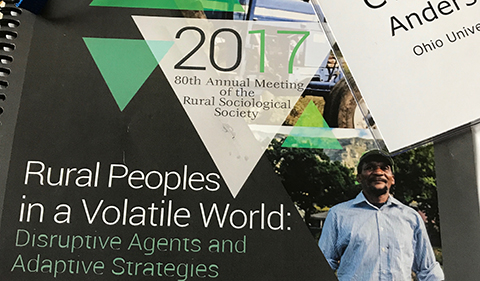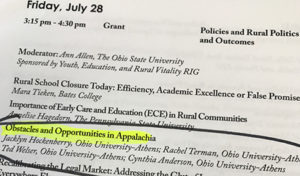
Dr. Rachel Terman, Assistant Professor of Sociology at Ohio University, presented “Obstacles and Opportunities in Appalachia” with colleagues Dr. Ted Welser, Associate Professor of Sociology, Dr. Cynthia Anderson, Professor of Sociology, and alum Jacklyn Hockenberry ’17 M.A. Sociology, at the 80th Annual Meeting of the Rural Sociological Society in July.
The topic of the meeting this year was Rural Peoples in a Volatile World: Disruptive Agents and Adaptive Strategies, with focus on the ways in which rural peoples cope with a wide range of disruptive events, whether economic downturns, severe storms and droughts (e.g. climate change), the arrival of outside investors, or wars. The strategies for coping vary by class and other related disadvantages, making some people much more vulnerable to the deliberate machinations of elites as well as to the almost random turns of events like storms and droughts.
The Rural Sociological Society is a professional social science association that promotes the generation, application, and dissemination of sociological knowledge. The society seeks to enhance the quality of rural life, communities, and the environment.

Abstract: Our research examines migration trends in Appalachia. We are interested in the social, economic and spatial factors that contribute to patterns of durable disadvantage and mobility, both upward and downward. This project extends work done by Jacklyn Hockenberry for her master’s degree in sociology. We use county level data from the American Community Survey and the U.S. Census Bureau to examine how attributes of counties that people move from are related to the attributes of the counties they move to. Preliminary results suggest that county level attributes like Appalachian region, distressed county status, employment rate, and education rate all describe a pattern of durable disadvantage in Appalachian states: migrating from a disadvantaged county increases the likelihood of moving to a distressed county. We find evidence of upward mobility from work age migrants who are less likely to move into a disadvantaged county; however, if the worker hails from an Appalachian county they are more likely to move into disadvantage. Finally, we consider the role of the county within the network of county migrations. Most notably, we find that emigrating from highly central counties reinforces durable advantage while migrants from isolated counties (with no measured in-migration) are more likely to migrate to a disadvantaged county. We conclude by considering directions for further research.
Our research is important for understanding the exacerbating components of distress in Appalachian counties as well as pathways for upward mobility of people who reside in these counties. Furthermore, the results provide insights into how distressed communities are connected by migration, which may be helpful in identifying opportunities for community development.



















Comments